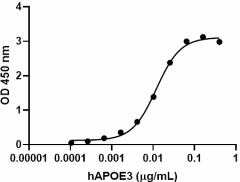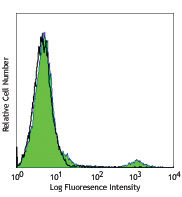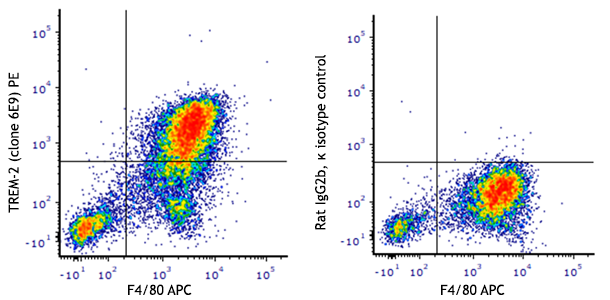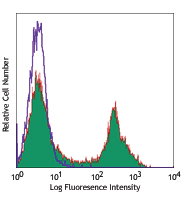- Regulatory Status
- RUO
- Other Names
- Triggering receptor expressed on myeloid cells-2, TREM-2, TREM2
- Ave. Rating
- Submit a Review
- Product Citations
- publications

-

When human TREM2-Fc Chimera is immobilized at 2.0 µg/mL, human APOE3 binds with an EC50 of 8-20 ng/mL. Purified anti-Apo E 109-116 antibody (Cat. No. 852701) and HRP goat anti-mouse IgG (minimal x-reactivity) antibody (Cat. No. 405306) was used to detect the binding. -

Stability testing for human TREM2-Fc Chimera. Recombinant human TREM2-Fc Chimera was aliquoted in PBS, pH 7.2 at 0.2 mg/mL. One aliquot was frozen and thawed four times (4x Freeze/Thaw), and compared to a control kept at 4°C (control). The samples were tested in a binding assay with human Apolipoprotein E3.
Human TREM2 (Triggering receptor expressed on myeloid cells-2) is a cell surface receptor and a member of the Ig superfamily with one V-type extracellular domain, a charged transmembrane domain, and a short cytoplasmic tail. TREM2 is expressed in a subgroup of myeloid cells including dendritic cells, granulocytes, and tissue-specific macrophages like osteoclasts, Kuppfer cells and alveolar macrophages. TREM2 is also selectively expressed in microglia, the innate immune cells of the CNS and variants of TREM2 have been linked to Alzheimer's disease. TREM2 is a receptor of the innate immune system and has been implicated in anti-inflammatory signaling in monocytes and microglia by inhibiting Toll-like receptor signaling and promoting phagocytosis of apoptotic cell membranes. TREM2 acts principally through the intracellular adaptor DAP12 (DNAX-activation protein 12) via its short cytoplasmic tail. TREM2 ligation generates tyrosine phosphorylation of DAP12 within its immunoreceptor tyrosine-based activation motifs (ITAMS) by Src family kinases which initiates a signaling cascade and a subsequent immune response. TREM2 associates with DAP12 to regulate osteoclast differentiation, migration and resorption. TREM2 has been shown to promote the phagocytosis of apoptotic neurons, cellular debris and bacterial products. TREM2 and TREM2-L form a receptor-ligand pair connecting microglia with apoptotic neurons, directing removal of damaged cells to allow repair. The ability of TREM2 to bind two known AD risk factors (APOE and CLU) and its strong influence on Aβ uptake, via lipoprotein association with Aβ aggregates, could explain the large genetic influence of TREM2 mutations in the risk of developing Alzheimer's disease.
Product DetailsProduct Details
- Source
- Human TREM2, amino acid His19 - Ser174 (Accession # Q9NZC2), with a C-terminal hIgG1 Fc and 6His tag was expressed in 293E cells.
- Molecular Mass
- The 401 amino acid recombinant protein has a predicted molecular mass of approximately 45.1 kD. The DTT-reduced protein migrates at approximately 60 kD and and non-reduced protein migrates at approximately 110 kD by SDS-PAGE. The predicted N-terminal amino acid is His.
- Purity
- >95%, as determined by Coomassie stained SDS-PAGE.
- Formulation
- 0.22 µm filtered protein solution is in PBS, pH 7.2.
- Endotoxin Level
- Less than 0.01 ng per µg cytokine as determined by the LAL method.
- Concentration
- 10 and 25 µg sizes are bottled at 200 µg/mL. 100 µg size and larger sizes are lot-specific and bottled at the concentration indicated on the vial. To obtain lot-specific concentration and expiration, please enter the lot number in our Certificate of Analysis online tool.
- Storage & Handling
- Unopened vial can be stored between 2°C and 8°C for up to 2 weeks, at -20°C for up to six months, or at -70°C or colder until the expiration date. For maximum results, quick spin vial prior to opening. The protein can be aliquoted and stored at -20°C or colder. Stock solutions can also be prepared at 50 - 100 µg/mL in appropriate sterile buffer, carrier protein such as 0.2 - 1% BSA or HSA can be added when preparing the stock solution. Aliquots can be stored between 2°C and 8°C for up to one week and stored at -20°C or colder for up to 3 months. Avoid repeated freeze/thaw cycles.
- Activity
- When Human TREM2-Fc Chimera is coated at 2.0 µg/mL (100 µL/well), human Apolipoprotein E3 binds with an EC50 of 8 - 32 ng/mL. Purified anti-Apo E 109-116 antibody (Cat. No. 852701) and HRP goat anti-mouse IgG (minimal x-reactivity) antibody (Cat. No. 405306) was used to detect the binding.
- Application
-
Bioassay
- Application Notes
-
BioLegend carrier-free recombinant proteins provided in liquid format are shipped on blue ice. Our comparison testing data indicates that when handled and stored as recommended, the liquid format has equal or better stability and shelf-life compared to commercially available lyophilized proteins after reconstitution. Our liquid proteins are verified in-house to maintain activity after shipping on blue ice and are backed by our 100% satisfaction guarantee. If you have any concerns, contact us at tech@biolegend.com.
Antigen Details
- Structure
- Disulfide-linked homodimer
- Distribution
-
Broadly distributed in normal adult tissues including brain, endocrine tissues, muscle tissues, lung, gastrointestinal tract, kidney, testis, and ovary.
- Function
- An innate immune receptor whose activation is involved in modulating inflammatory signalling in a specific sub-group of myeloid cells.
- Interaction
- Myeloid cells, microglia, macrophages
- Ligand/Receptor
- CLU/TREM2, APOE/TREM2
- Bioactivity
- Measured by its ability to bind hAPOE3 using a functional ELISA.
- Cell Type
- Dendritic cells, Granulocytes, Macrophages, Microglia, Monocytes, Osteoclasts
- Biology Area
- Cell Biology, Innate Immunity, Neuroinflammation, Neuroscience
- Molecular Family
- Soluble Receptors
- Antigen References
-
- Turnbull IR, et al. 2006. J. Immunol. 177:3520-24.
- Yeh FL, et al. 2016. Neuron. 10.1016/j.neuron.2016.06.015.
- Gratuze M, et al. 2018. Mol Neurodegener. 10.1186/s13024-018-0298-9.
- Humphrey MB, et al. 2006. J. Bone Miner. Res. 21:237-45.
- Hsieh C, et al. 2009. J. Neurochem. 109: 1144-1156.
- Gene ID
- 54209 View all products for this Gene ID
- UniProt
- View information about TREM2 on UniProt.org
Related FAQs
- Why choose BioLegend recombinant proteins?
-
• Each lot of product is quality-tested for bioactivity as indicated on the data sheet.
• Greater than 95% Purity or higher, tested on every lot of product.
• 100% Satisfaction Guarantee for quality performance, stability, and consistency.
• Ready-to-use liquid format saves time and reduces challenges associated with reconstitution.
• Bulk and customization available. Contact us.
• Learn more about our Recombinant Proteins. - How does the activity of your recombinant proteins compare to competitors?
-
We quality control each and every lot of recombinant protein. Not only do we check its bioactivity, but we also compare it against other commercially available recombinant proteins. We make sure each recombinant protein’s activity is at least as good as or better than the competition’s. In order to provide you with the best possible product, we ensure that our testing process is rigorous and thorough. If you’re curious and eager to make the switch to BioLegend recombinants, contact your sales representative today!
- What is the specific activity or ED50 of my recombinant protein?
-
The specific activity range of the protein is indicated on the product datasheets. Because the exact activity values on a per unit basis can largely fluctuate depending on a number of factors, including the nature of the assay, cell density, age of cells/passage number, culture media used, and end user technique, the specific activity is best defined as a range and we guarantee the specific activity of all our lots will be within the range indicated on the datasheet. Please note this only applies to recombinants labeled for use in bioassays. ELISA standard recombinant proteins are not recommended for bioassay usage as they are not tested for these applications.
- Have your recombinants been tested for stability?
-
Our testing shows that the recombinant proteins are able to withstand room temperature for a week without losing activity. In addition the recombinant proteins were also found to withstand four cycles of freeze and thaw without losing activity.
- Does specific activity of a recombinant protein vary between lots?
-
Specific activity will vary for each lot and for the type of experiment that is done to validate it, but all passed lots will have activity within the established ED50 range for the product and we guarantee that our products will have lot-to-lot consistency. Please conduct an experiment-specific validation to find the optimal ED50 for your system.
- How do you convert activity as an ED50 in ng/ml to a specific activity in Units/mg?
-
Use formula Specific activity (Units/mg) = 10^6/ ED50 (ng/mL)
Customers Also Purchased



 Login / Register
Login / Register 










Follow Us